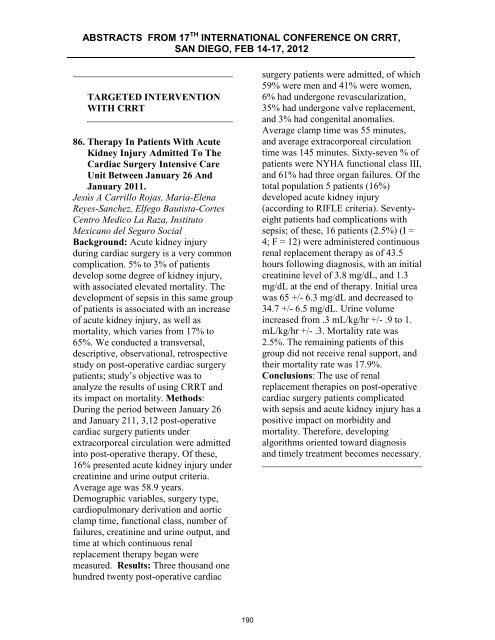ABSTRACTS from 16th International COnference on ... - CRRT Online
ABSTRACTS from 16th International COnference on ... - CRRT Online
ABSTRACTS from 16th International COnference on ... - CRRT Online
You also want an ePaper? Increase the reach of your titles
YUMPU automatically turns print PDFs into web optimized ePapers that Google loves.
<str<strong>on</strong>g>ABSTRACTS</str<strong>on</strong>g> FROM 17 TH INTERNATIONAL CONFERENCE ON <strong>CRRT</strong>,<br />
SAN DIEGO, FEB 14-17, 2012<br />
TARGETED INTERVENTION<br />
WITH <strong>CRRT</strong><br />
86. Therapy In Patients With Acute<br />
Kidney Injury Admitted To The<br />
Cardiac Surgery Intensive Care<br />
Unit Between January 26 And<br />
January 2011.<br />
Jesús A Carrillo Rojas, Maria-Elena<br />
Reyes-Sanchez, Elfego Bautista-Cortes<br />
Centro Medico La Raza, Instituto<br />
Mexicano del Seguro Social<br />
Background: Acute kidney injury<br />
during cardiac surgery is a very comm<strong>on</strong><br />
complicati<strong>on</strong>. 5% to 3% of patients<br />
develop some degree of kidney injury,<br />
with associated elevated mortality. The<br />
development of sepsis in this same group<br />
of patients is associated with an increase<br />
of acute kidney injury, as well as<br />
mortality, which varies <str<strong>on</strong>g>from</str<strong>on</strong>g> 17% to<br />
65%. We c<strong>on</strong>ducted a transversal,<br />
descriptive, observati<strong>on</strong>al, retrospective<br />
study <strong>on</strong> post-operative cardiac surgery<br />
patients; study’s objective was to<br />
analyze the results of using <strong>CRRT</strong> and<br />
its impact <strong>on</strong> mortality. Methods:<br />
During the period between January 26<br />
and January 211, 3,12 post-operative<br />
cardiac surgery patients under<br />
extracorporeal circulati<strong>on</strong> were admitted<br />
into post-operative therapy. Of these,<br />
16% presented acute kidney injury under<br />
creatinine and urine output criteria.<br />
Average age was 58.9 years.<br />
Demographic variables, surgery type,<br />
cardiopulm<strong>on</strong>ary derivati<strong>on</strong> and aortic<br />
clamp time, functi<strong>on</strong>al class, number of<br />
failures, creatinine and urine output, and<br />
time at which c<strong>on</strong>tinuous renal<br />
replacement therapy began were<br />
measured. Results: Three thousand <strong>on</strong>e<br />
hundred twenty post-operative cardiac<br />
surgery patients were admitted, of which<br />
59% were men and 41% were women,<br />
6% had underg<strong>on</strong>e revascularizati<strong>on</strong>,<br />
35% had underg<strong>on</strong>e valve replacement,<br />
and 3% had c<strong>on</strong>genital anomalies.<br />
Average clamp time was 55 minutes,<br />
and average extracorporeal circulati<strong>on</strong><br />
time was 145 minutes. Sixty-seven % of<br />
patients were NYHA functi<strong>on</strong>al class III,<br />
and 61% had three organ failures. Of the<br />
total populati<strong>on</strong> 5 patients (16%)<br />
developed acute kidney injury<br />
(according to RIFLE criteria). Seventyeight<br />
patients had complicati<strong>on</strong>s with<br />
sepsis; of these, 16 patients (2.5%) (I =<br />
4; F = 12) were administered c<strong>on</strong>tinuous<br />
renal replacement therapy as of 43.5<br />
hours following diagnosis, with an initial<br />
creatinine level of 3.8 mg/dL, and 1.3<br />
mg/dL at the end of therapy. Initial urea<br />
was 65 +/- 6.3 mg/dL and decreased to<br />
34.7 +/- 6.5 mg/dL. Urine volume<br />
increased <str<strong>on</strong>g>from</str<strong>on</strong>g> .3 mL/kg/hr +/- .9 to 1.<br />
mL/kg/hr +/- .3. Mortality rate was<br />
2.5%. The remaining patients of this<br />
group did not receive renal support, and<br />
their mortality rate was 17.9%.<br />
C<strong>on</strong>clusi<strong>on</strong>s: The use of renal<br />
replacement therapies <strong>on</strong> post-operative<br />
cardiac surgery patients complicated<br />
with sepsis and acute kidney injury has a<br />
positive impact <strong>on</strong> morbidity and<br />
mortality. Therefore, developing<br />
algorithms oriented toward diagnosis<br />
and timely treatment becomes necessary.<br />
190
















